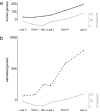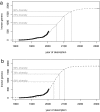Estimating the diversity of dinosaurs
- PMID: 16954187
- PMCID: PMC1564218
- DOI: 10.1073/pnas.0606028103
Estimating the diversity of dinosaurs
Abstract
Despite current interest in estimating the diversity of fossil and extant groups, little effort has been devoted to estimating the diversity of dinosaurs. Here we estimate the diversity of nonavian dinosaurs at approximately 1,850 genera, including those that remain to be discovered. With 527 genera currently described, at least 71% of dinosaur genera thus remain unknown. Although known diversity declined in the last stage of the Cretaceous, estimated diversity was steady, suggesting that dinosaurs as a whole were not in decline in the 10 million years before their ultimate extinction. We also show that known diversity is biased by the availability of fossiliferous rock outcrop. Finally, by using a logistic model, we predict that 75% of discoverable genera will be known within 60-100 years and 90% within 100-140 years. Because of nonrandom factors affecting the process of fossil discovery (which preclude the possibility of computing realistic confidence bounds), our estimate of diversity is likely to be a lower bound.
Conflict of interest statement
Conflict of interest statement: No conflicts declared.
Figures



References
-
- Russell DA. Historical Biol. 1995;10:3–12.
-
- Weishampel DB, Jianu C-M. In: Evolution of Herbivory in Terrestrial Vertebrates: Perspectives from the Fossil Record. Sues HD, editor. Cambridge, UK: Cambridge Univ Press; 2000. pp. 123–143.
-
- Weishampel DB, Dodson P, Osmolska H. The Dinosauria. 1st Ed. Berkeley: Univ of California Press; 1990.
Publication types
MeSH terms
LinkOut - more resources
Full Text Sources
Other Literature Sources

